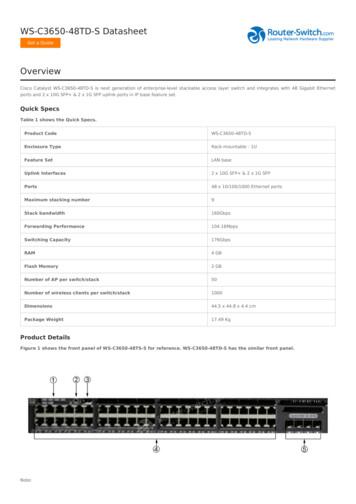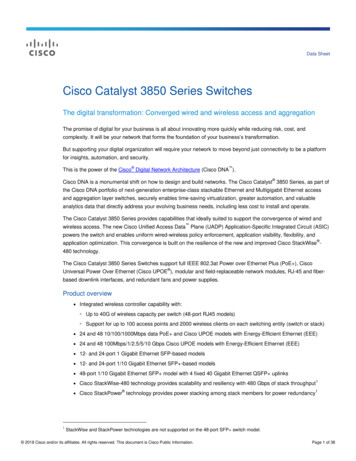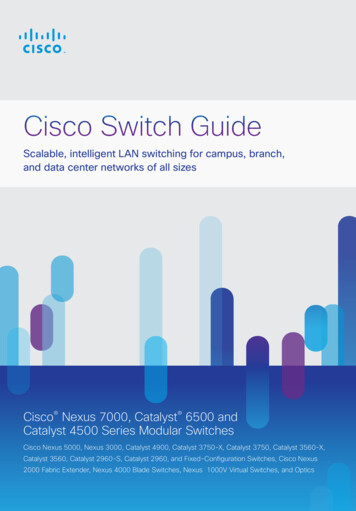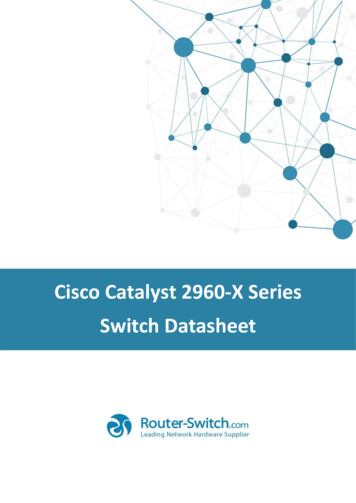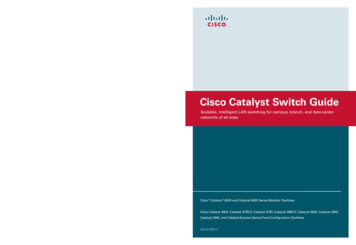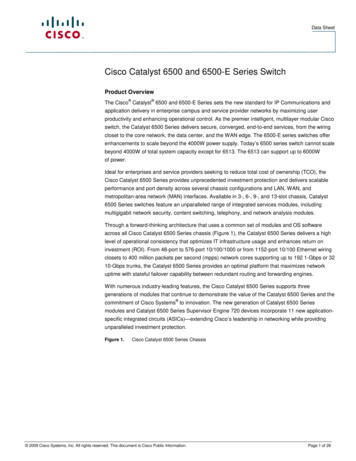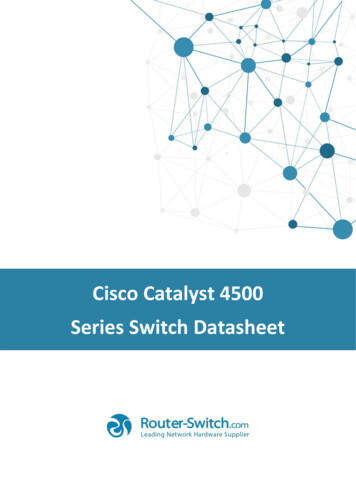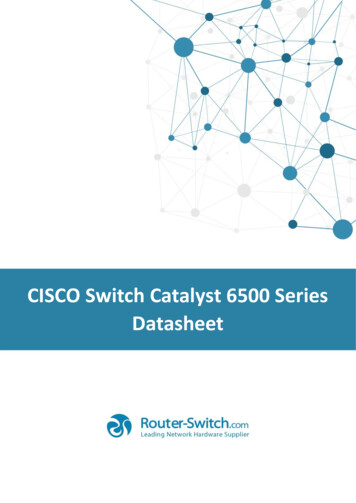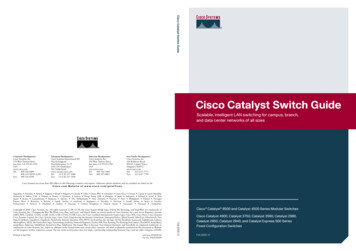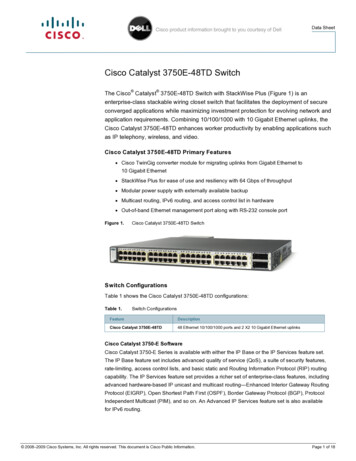
Transcription
Data SheetCisco Catalyst 3750E-48TD Switch The Cisco Catalyst 3750E-48TD Switch with StackWise Plus (Figure 1) is anenterprise-class stackable wiring closet switch that facilitates the deployment of secureconverged applications while maximizing investment protection for evolving network andapplication requirements. Combining 10/100/1000 with 10 Gigabit Ethernet uplinks, theCisco Catalyst 3750E-48TD enhances worker productivity by enabling applications suchas IP telephony, wireless, and video.Cisco Catalyst 3750E-48TD Primary Features Cisco TwinGig converter module for migrating uplinks from Gigabit Ethernet to10 Gigabit Ethernet StackWise Plus for ease of use and resiliency with 64 Gbps of throughput Modular power supply with externally available backup Multicast routing, IPv6 routing, and access control list in hardware Out-of-band Ethernet management port along with RS-232 console portFigure 1.Cisco Catalyst 3750E-48TD SwitchSwitch ConfigurationsTable 1 shows the Cisco Catalyst 3750E-48TD configurations:Table 1.Switch ConfigurationsFeatureDescriptionCisco Catalyst 3750E-48TD48 Ethernet 10/100/1000 ports and 2 X2 10 Gigabit Ethernet uplinksCisco Catalyst 3750-E SoftwareCisco Catalyst 3750-E Series is available with either the IP Base or the IP Services feature set.The IP Base feature set includes advanced quality of service (QoS), a suite of security features,rate-limiting, access control lists, and basic static and Routing Information Protocol (RIP) routingcapability. The IP Services feature set provides a richer set of enterprise-class features, includingadvanced hardware-based IP unicast and multicast routing—Enhanced Interior Gateway RoutingProtocol (EIGRP), Open Shortest Path First (OSPF), Border Gateway Protocol (BGP), ProtocolIndependent Multicast (PIM), and so on. An Advanced IP Services feature set is also availablefor IPv6 routing. 2008–2009 Cisco Systems, Inc. All rights reserved. This document is Cisco Public Information.Page 1 of 18
Data SheetCustomers can transparently upgrade the software feature set in the Cisco Catalyst 3750-E Series Switches through Cisco IOS Software Activation. Software activation authorizes andenables the Cisco IOS Software feature sets. A special file contained in the switch, called alicense file, is examined by Cisco IOS Software when the switch is powered on. Based on thelicense’s type, Cisco IOS Software activates the appropriate feature set. License types can bechanged, or upgraded, to activate a different feature set. For detailed information about SoftwareActivation, visit http://www.cisco.com/go/sa.Investment ProtectionThe Cisco Catalyst 3750-E Series Switches are compatible with the Cisco Catalyst 3750 SeriesSwitches, enabling customers to stack them together and thereby protect existing investment in theCisco Catalyst 3750 Series Switches. The Cisco TwinGig Small Form-Factor Pluggable (SFP)converter module further protects customers’ investment in Cisco Catalyst 3750-E Series Switchesby enabling migration from Gigabit Ethernet to 10 Gigabit Ethernet uplinks, as business needsrequire, without having to upgrade the switches.Cisco StackWise Plus TechnologyCisco StackWise Plus technology is built on the highly successful StackWise technology, whichis a premium stacking architecture optimized for Gigabit Ethernet. StackWise technology wasdesigned to respond to additions, deletions, and redeployment while maintaining constantperformance. The stack behaves as a single switching unit that is managed by a master switchelected from one of the member switches. The master switch automatically creates and updates allthe switching and optional routing tables. A working stack can accept new members or delete oldones without service interruption. StackWise creates a highly resilient single unified system of up tonine switches, providing simplified management using a single IP address, single telnet session,single command-line interface (CLI), auto-version checking, autoconfiguration, and more.StackWise Plus supports all the features of StackWise and provides backward compatibility withthe existing Cisco Catalyst 3750 Series Switches while enhancing the throughput of the system upto 64 Gbps. StackWise Plus also enables local switching in Cisco Catalyst 3750-E Series Switches.Local switching packets coming into a port in the Cisco Catalyst 3750-E Series Switch destined foranother port in the same switch do not have to traverse through the stack ring, thus increasing theforwarding capacity of the switch.10 Gigabit Ethernet Uplinks and the Cisco TwinGig SFP ConverterThe Cisco Catalyst 3750-E features wire-speed 10 Gigabit Ethernet uplink ports for high-bandwidthapplications, relieving congestion and ensuring smooth delivery of data. The TwinGig SFPconverter (see Figure 2) converts a 10 Gigabit Ethernet X2 interface into two Gigabit Ethernet SFPports. This way, customers can initially use the switch with Gigabit Ethernet uplinks and laterimplement 10 Gigabit Ethernet uplinks as business demands change, without having to upgradethe access layer. 2008–2009 Cisco Systems, Inc. All rights reserved. This document is Cisco Public Information.Page 2 of 18
Data SheetFigure 2.Cisco TwinGig Adapter Converting 10 Gigabit Ethernet X2 Interface into Two Gigabit EthernetSFP InterfacesModular Power SuppliesThe Cisco Catalyst 3750E-48TD Switch has one power supply slot and supports the followingpower supplies. C3K-PWR-265WAC: 265WAC power supply for 48-port or 24-port switch without PoE C3K-PWR-265WDC: 265WDC power supply for 48-port or 24-port switch without PoEMaximum power availability for converged voice and data networks is attainable when a CiscoCatalyst 3750E-48TD Switch is combined with the Cisco RPS 2300 Redundant Power System fortransparent protection against internal power supply failures and an uninterruptible power supply(UPS) system to safeguard against power outages. Using the RPS 2300 to provide backup power,the Cisco Catalyst 3750E-48TD Switch power supply becomes hot swappable. Table 4 shows thepower supply compatibility matrix.Redundant Power SystemThe Cisco Catalyst 3750-E Series Switches support the new generation of Redundant PowerSupply (RPS) 2300. The RPS 2300 increases availability in a converged data, voice, and videonetwork by providing transparent power backup to two of six attached Cisco Catalyst 3750-E SeriesSwitches at the same time. The failed power supply can be swapped out while the switch is beingpowered up by the RPS 2300.Primary Features and BenefitsEase of Use: DeploymentA working stack is self-managing and self-configuring. When switches are added or removed, themaster switch automatically loads the Cisco IOS Software version running on the stack to the newswitch, loads the global configuration parameters, and updates all the routing tables to reflectchanges. Upgrades are applied universally and simultaneously to all members of the stack.The Cisco Catalyst 3750-E Series stacks up to nine switches as a single logical unit for a total of468 Ethernet 10/100/1000 ports or 18 10 Gigabit Ethernet ports. Individual 10/100/1000 units canbe joined in any combination to evolve with network needs.Other ease of use features include but are not limited to: Smartports enable fast and easy configuration of Cisco recommended best practice securityand QoS features, encapsulating years of Cisco networking expertise. 2008–2009 Cisco Systems, Inc. All rights reserved. This document is Cisco Public Information.Page 3 of 18
Data Sheet Dynamic Host Configuration Protocol (DHCP) autoconfiguration of multiple switches througha boot server eases switch deployment. Automatic QoS (AutoQoS) simplifies QoS configuration in voice over IP (VoIP) networks byissuing interface and global switch commands to detect Cisco IP phones, classify traffic, andhelp enable egress queue configuration. Master configuration management helps ensure that all switches are automaticallyupgraded when the master switch receives a new software version. Automatic softwareversion checking and updating help ensure that all stack members have the same softwareversion. Autonegotiation on all ports automatically selects half- or full-duplex transmission mode tooptimize bandwidth. Dynamic Trunking Protocol (DTP) facilitates dynamic trunk configuration across allswitch ports. Port Aggregation Protocol (PAgP) automates the creation of Cisco Fast EtherChannelgroups or Gigabit EtherChannel groups to link to another switch, router, or server. Link Aggregation Control Protocol (LACP) allows the creation of Ethernet channeling withdevices that conform to IEEE 802.3ad. This feature is similar to Cisco EtherChanneltechnology and PAgP. Automatic media-dependent interface crossover (MDIX) automatically adjusts transmit andreceive pairs if an incorrect cable type (crossover or straight-through) is installed. Unidirectional Link Detection Protocol (UDLD) and Aggressive UDLD allow unidirectionallinks caused by incorrect fiber-optic wiring or port faults to be detected and disabled onfiber-optic interfaces.High AvailabilityThe Cisco Catalyst 3750-E Series increases availability for stackable switches. Each switch canoperate both as master controller and as forwarding processor. Each switch in the stack can serveas a master, creating a 1:N availability scheme for network control. In the unlikely event of a singleunit failure, all other units continue to forward traffic and maintain operation.Other high-availability features include but are not limited to: Cross-Stack EtherChannel provides the ability to configure Cisco EtherChannel technologyacross different members of the stack for high resiliency. Flexlink provides link redundancy with convergence time less than 100 ms. IEEE 802.1s/w Rapid Spanning Tree Protocol (RSTP) and Multiple Spanning Tree Protocol(MSTP) provide rapid spanning-tree convergence independent of spanning-tree timers andalso offers the benefit of Layer 2 load balancing and distributed processing. Stacked unitsbehave as a single spanning-tree node. Per-VLAN Rapid Spanning Tree (PVRST ) allows rapid spanning-tree reconvergence on aper-VLAN spanning-tree basis, without requiring the implementation of spanning-treeinstances. Cisco Hot Standby Router Protocol (HSRP) is supported to create redundant, failsaferouting topologies. Switch-port autorecovery (Errdisable) automatically attempts to reactivate a link that isdisabled because of a network error. 2008–2009 Cisco Systems, Inc. All rights reserved. This document is Cisco Public Information.Page 4 of 18
Data SheetHigh-Performance IP RoutingCisco Express Forwarding hardware routing architecture delivers extremely high-performance IProuting in the Cisco Catalyst 3750-E Series Switches. IP unicast routing protocols (Static, Routing Information Protocol Version 1 [RIPv1], andRIPv2, RIPng, EIGRP stub) are supported for small-network routing applications. Advanced IP unicast routing protocols (OSPF, EIGRP, BGPv4 and IS-ISv4) are supportedfor load balancing and constructing scalable LANs. The IP Services feature set is required. IPv6 routing (RIPing, OSPFv3) is supported in hardware for maximum performance.Advanced IP Services feature set is required for IPv6 routing. Equal-cost routing facilitates Layer 3 load balancing and redundancy across the stack. Policy-based routing (PBR) allows superior control by facilitating flow redirection regardlessof the routing protocol configured. The IP Services feature set is required. HSRP provides dynamic load balancing and failover for routed links, up to 32 HSRP linkssupported per unit or stack. Protocol Independent Multicast (PIM) for IP multicast routing is supported, including PIMsparse mode (PIM-SM), PIM dense mode (PIM-DM), PIM sparse-dense mode. The IPServices feature set is required. Distance Vector Multicast Routing Protocol (DVMRP) tunneling interconnects 2 multicastenabled networks across nonmulticast networks. The IP Services feature set is required. Fallback bridging forwards non-IP traffic between two or more VLANs. The IP Servicesfeature set is required.Superior Quality of ServiceThe Cisco Catalyst 3750-E Series offers Gigabit Ethernet speed with intelligent services that keepeverything flowing smoothly, even at 10 times the normal network speed. Industry-leadingmechanisms for marking, classification, and scheduling deliver superior performance for data,voice, and video traffic, all at wire speed.Following are some of the QoS features supported in the Cisco Catalyst 3750-E Series Switches: Cross-stack QoS allows QoS to be configured across the entire stack. 802.1p class of service (CoS) and differentiated services code point (DSCP) fieldclassification is provided, using marking and reclassification on a per-packet basis by sourceand destination IP address, MAC address, or Layer 4 TCP/UDP port number. Cisco control-plane and data-plane QoS ACLs on all ports help ensure proper marking on aper-packet basis. Four egress queues per port help enable differentiated management of up to four traffictypes across the stack. Shaped Round Robin (SRR) scheduling helps ensure differential prioritization of packetflows by intelligently servicing the ingress queues and egress queues. Weighted Tail Drop (WTD) provides congestion avoidance at the ingress and egressqueues before a disruption occurs. Strict priority queuing helps ensure that the highest-priority packets are serviced ahead of allother traffic. 2008–2009 Cisco Systems, Inc. All rights reserved. This document is Cisco Public Information.Page 5 of 18
Data Sheet The Cisco committed information rate (CIR) function provides bandwidth in increments aslow as 8 Kbps. Rate limiting is provided based on source and destination IP address, source anddestination MAC address, Layer 4 TCP/UDP information, or any combination of these fields,using QoS ACLs (IP ACLs or MAC ACLs), class maps, and policy maps. Up to 64 aggregate or individual policers are available per Fast Ethernet or GigabitEthernet port.Advanced SecurityThe Cisco Catalyst 3750-E Series supports a comprehensive set of security features forconnectivity and access control, including ACLs, authentication, port-level security, and identitybased network services with 802.1x and extensions. This set of comprehensive features not onlyhelps prevent external attacks, but defends the network against “man-in-the-middle” attacks, aprimary concern in today’s business environment. The switch also supports the Network AdmissionControl (NAC) security framework. Dynamic ARP Inspection (DAI) helps ensure user integrity by preventing malicious usersfrom exploiting the insecure nature of the ARP protocol. DHCP Snooping prevents malicious users from spoofing a DHCP server and sending outbogus addresses. This feature is used by other primary security features to prevent anumber of other attacks such as ARP poisoning. IP source guard prevents a malicious user from spoofing or taking over another user’s IPaddress by creating a binding table between the client’s IP and MAC address, port, andVLAN. Private VLANs restrict traffic between hosts in a common segment by segregating traffic atLayer 2, turning a broadcast segment into a nonbroadcast multi-access-like segment. Private VLAN Edge provides security and isolation between switch ports, which helpsensure that users cannot snoop on other users’ traffic. Unicast RPF feature helps mitigate problems caused by the introduction of malformed orforged (spoofed) IP source addresses into a network by discarding IP packets that lack averifiable IP source address. IEEE 802.1x allows dynamic, port-based security, providing user authentication. IEEE 802.1x with VLAN assignment allows a dynamic VLAN assignment for a specific userregardless of where the user is connected. IEEE 802.1x with voice VLAN permits an IP phone to access the voice VLAN irrespective ofthe authorized or unauthorized state of the port. IEEE 802.1x and port security are provided to authenticate the port and manage networkaccess for all MAC addresses, including that of the client. IEEE 802.1x with an ACL assignment allows for specific identity-based security policiesregardless of where the user is connected. IEEE 802.1x with guest VLAN allows guests without 802.1x clients to have limited networkaccess on the guest VLAN. Web authentication for non-802.1x clients allows non-802.1x clients to use an SSL-basedbrowser for authentication. 2008–2009 Cisco Systems, Inc. All rights reserved. This document is Cisco Public Information.Page 6 of 18
Data Sheet Multi-Domain Authentication allows an IP phone and a PC to authenticate on the sameswitch port while placing them on appropriate Voice and Data VLAN. MAC Auth Bypass (MAB) for voice allows third-party IP phones without an 802.1x supplicantto get authenticated using the MAC address. Cisco security VLAN ACLs on all VLANs prevents unauthorized data flows from beingbridged within VLANs. Cisco standard and extended IP security router ACLs define security policies on routedinterfaces for control-plane and data-plane traffic. IPv6 ACLs can be applied to filterIPv6 traffic. Port-based ACLs for Layer 2 interfaces allow security policies to be applied on individualswitch ports. Secure Shell (SSH) Protocol, Kerberos, and Simple Network Management Protocol Version3 (SNMPv3) provide network security by encrypting administrator traffic during Telnet andSNMP sessions. SSH Protocol, Kerberos, and the cryptographic version of SNMPv3 requirea special cryptographic software image because of U.S. export restrictions. Bidirectional data support on the Switched Port Analyzer (SPAN) port allows Cisco IntrusionDetection System (IDS) to take action when an intruder is detected. TACACS and RADIUS authentication facilitates centralized control of the switch andrestricts unauthorized users from altering the configuration. MAC Address Notification allows administrators to be notified of users added to or removedfrom the network. Port Security secures the access to an access or trunk port based on MAC address. Multilevel security on console access prevents unauthorized users from altering the switchconfiguration. Bridge protocol data unit (BPDU) Guard shuts down Spanning Tree PortFast-enabledinterfaces when BPDUs are received to avoid accidental topology loops. Spanning Tree Root Guard (STRG) prevents edge devices not in the networkadministrator’s control from becoming Spanning Tree Protocol root nodes. IGMP filtering provides multicast authentication by filtering out nonsubscribers and limits thenumber of concurrent multicast streams available per port. Dynamic VLAN assignment is supported through implementation of VLAN MembershipPolicy Server client capability to provide flexibility in assigning ports to VLANs. DynamicVLAN facilitates the fast assignment of IP addresses.Management and Control FeaturesEach Cisco Catalyst 3750-E Series stack is managed as a single object and has a single IPaddress. The primary management and control features in the Cisco Catalyst 3750E-ESwitches include: Cisco IOS Software CLI support provides common user interface and command set with allCisco routers and Cisco Catalyst desktop switches. Switching Database Manager Templates for access, routing, and VLAN deployment allowthe administrator to easily maximize memory allocation to the desired features based ondeployment-specific requirements. 2008–2009 Cisco Systems, Inc. All rights reserved. This document is Cisco Public Information.Page 7 of 18
Data Sheet Generic On-Line Diagnostic (GOLD) checks the health of hardware components and verifiesproper operation of the system data and control plane at run time and boot time. Virtual routing and forwarding (VRF)-Lite enables a service provider to support two or moreVPNs, with overlapping IP addresses. Local Proxy Address Resolution Protocol (ARP) works in conjunction with Private VLANEdge to minimize broadcasts and maximize available bandwidth. VLAN1 minimization allows VLAN1 to be disabled on any individual VLAN trunk. Smart Multicast, with Cisco StackWise Plus technology, allows the Cisco Catalyst 3750-ESeries to offer greater efficiency and support for more multicast data streams such as videoby putting each data packet onto the backplane only once. Internet Group Management Protocol (IGMP) Snooping for IPv4 and IPv6 MLD v1 and v2Snooping provide fast client joins and leaves of multicast streams and limit bandwidthintensive video traffic to only the requestors. Multicast VLAN Registration (MVR) continuously sends multicast streams in a multicastVLAN while isolating the streams from subscriber VLANs for bandwidth and securityreasons. Per-port broadcast, multicast, and unicast storm control prevents faulty end stations fromdegrading overall systems performance. Voice VLAN simplifies telephony installations by keeping voice traffic on a separate VLANfor easier administration and troubleshooting. Cisco VLAN Trunking Protocol (VTP) supports dynamic VLANs and dynamic trunkconfiguration across all switches. Remote Switch Port Analyzer (RSPAN) allows administrators to remotely monitor ports in aLayer 2 switch network from any other switch in the same network. For enhanced traffic management, monitoring, and analysis, the Embedded RemoteMonitoring (RMON) software agent supports four RMON groups (history, statistics, alarms,and events). Layer 2 traceroute eases troubleshooting by identifying the physical path that a packet takesfrom source to destination. Trivial File Transfer Protocol (TFTP) reduces the cost of administering software upgrades bydownloading from a centralized location. Network Timing Protocol (NTP) provides an accurate and consistent timestamp to allintranet switches. Multifunction LEDs per port for port status; half-duplex and full-duplex mode; and 10BASET, 100BASE-TX, and 1000BASE-T indication as well as switch-level status LEDs forsystem, redundant-power supply, and bandwidth utilization provide a comprehensive andconvenient visual management system. Jumbo frames (9216 bytes) are available on the 10/100/1000 configurations for advanceddata and video applications requiring very large frames.Network Management ToolsThe Cisco Catalyst 3750-E Series offers both a superior CLI for detailed configuration and CiscoNetwork Assistant Software, a PC-based tool for quick configuration based on preset templates. Inaddition, CiscoWorks LAN Management Solution (LMS) supports the Cisco Catalyst 3750-E Seriesfor networkwide management. 2008–2009 Cisco Systems, Inc. All rights reserved. This document is Cisco Public Information.Page 8 of 18
Data SheetCisco Network AssistantA PC-based network management application designed for small and medium-sized business(SMB) networks with up to 250 users, Cisco Network Assistant offers centralized networkmanagement and configuration capabilities. Cisco Network Assistant uses Cisco Smartportstechnology to simplify both initial deployment and ongoing maintenance. This application alsofeatures an intuitive GUI where users can easily apply common services across Cisco switches,routers, and access points, such as: Configuration management Troubleshooting advice Inventory reports Event notification Network security settings Password synchronization Drag-and-drop Cisco IOS Software upgrades Secure wirelessFor detailed information about Cisco Network Assistant, visit http://www.cisco.com/go/cna.CiscoWorks LAN Management Solution (LMS)CiscoWorks LMS is a suite of powerful management tools that simplify the configuration,administration, monitoring and troubleshooting of Cisco networks. It integrates these capabilitiesinto a world-class solution for improving the accuracy and efficiency of your operations staff, whileincreasing the overall availability of your network. LMS supports over 400 different device typesincluding the 3750-E and 3560-E series switches and it provides: Network discovery, topology views, end-station tracking and VLAN management Real-time network fault analysis with easy-to-deploy device specific best-practice templates Hardware and software inventory management, centralized configuration tools, and Syslogmonitoring Network response time and availability monitoring and tracking Real-time device, link, and port traffic management, analysis, and reportingFor detailed information about CiscoWorks LMS, go ps2425/index.html 2008–2009 Cisco Systems, Inc. All rights reserved. This document is Cisco Public Information.Page 9 of 18
Data SheetProduct SpecificationsTable 2 lists product specifications for the Cisco Catalyst 3750E-48TD Switch.Table 2.Descriptions and SpecificationsDescriptionPerformanceSpecification 160-Gbps switching fabric capacity Stack-forwarding rate of 95 Mpps for 64-byte packets Forwarding rate: 3750E-48TD—101.2 Mpps Memory: 256 MB DRAM and 64 MB FLASH Feature resources: 1005 VLANs4K VLAN IDs1000 switched virtual interfaces (SVIs)468 routed ports per stack9216 byte jumbo framesMAC, routing, security, and QoS scalability numbers depend on the type template usedin the switch:Connectors and CablingDefaultAccessVLANRoutingMAC address6K4K12K3KIGMP groups andmulticast routes1K1K1K1KTotal unicast routes8K6K011KDirectly connected hosts 6K4K03KIndirect routes2K2K08KSecurity ACEs1K2K1K1KQoS ACEs0.5K0.5K0.5K0.5KPBR ACEs00.5K00.5K 1000BASE-T ports: RJ-45 connectors, 2-pair Cat-5E UTP cabling 1000BASE-T SFP-based ports: RJ-45 connectors, 2-pair Cat-5E UTP cabling 100BASE-FX, 1000BASE-SX, -LX/LH, -ZX, -BX10, and CWDM SFP-based ports: LC fiberconnectors (single-mode or multimode fiber) 10GBASE-SR, LR, ER, LX4, CX4 X2-based ports: SC fiber connectors (single-mode ormultimode fiber) Cisco StackWise stacking ports: copper-based Cisco StackWise cabling Ethernet Management port: RJ-45 connectors, 2-pair Cat-5 UTP cabling Management console port: RJ-45-to-DB9 cable for PC connectionsPower Connectors Customers can provide power to a switch by using either the internal power supply or theCisco RPS 2300. The connectors are located at the back of the switch. Internal power supply connector: The internal power supply is an autoranging unit. Theinternal power supply supports input voltages between 100 and 240VAC. Use the suppliedAC power cord to connect the AC power connector to an AC power outlet. Cisco RPS connector: The connector offers connection for an optional Cisco RPS 2300 thatuses AC input and supplies DC output to the switch. Only the Cisco RPS 2300 (model PWR2300-AC-RPS-N1 ) should be attached to theredundant-power-supply receptacle.Indicators Per-port status LEDs: link integrity, disabled, activity, speed, and full-duplex indications System-status LEDs: system, RPS, and bandwidth-utilization indications 2008–2009 Cisco Systems, Inc. All rights reserved. This document is Cisco Public Information.Page 10 of 18
Data SheetDescriptionSpecificationDimensions (H x W x D)3750E-48TDWeightInchesCentimeters1.75 x 17.5 x 18.14.45 x 44.5 x 46.0Pounds3750E-48TDEnvironmental RangesKilograms18.88.6 Operating temperature: 32 to 113ºF (0 to 45ºC) Storage temperature: –13 to 158ºF (–25 to 70ºC) Relative humidity operating: 10 to 85% (noncondensing) Relative humidity nonoperating: 0 to 95% (noncondensing) Operating altitude: up to 10,000 ft (3049 m) Storage altitude: up to 15,000 ft (4573 m)Acoustic NoiseMean Time BetweenFailure (MTBF)International Organization for Standardization (ISO) 7779: bystander position operating toan ambient temperature of 30ºC3750E-48TD45 dB3750E-48TD166,369 hoursTable 3 lists the management and standards support for the Cisco Catalyst 3750E-48TD Switch.Table 3.Management and Standards Support for the Cisco Catalyst 3750-E Series SwitchDescriptionManagementStandardsSpecification BRIDGE-MIB CISCO-CDP-MIB CISCO-VTP-MIB ENTITY-MIB CISCO-CLUSTER-MIB CISCO-CONFIG-MAN-MIB ETHERLIKE-MIB IF-MIB CISCO-ENTITY-FRU-CONTROL-MIB CISCO-ENVMON-MIB IGMP-MIB IPMROUTE-MIB CISCO-FLASH-MIB CISCO-FTP-CLIENT-MIB OLD-CISCO-CHASSIS-MIB OLD-CISCO-FLASH-MIB CISCO-HSRP-MIB CISCO-HSRP-EXT-MIB OLD-CISCO-INTERFACES-MIB OLD-CISCO-IP-MIB CISCO-IGMP-FILTER-MIB CISCO-IMAGE-MIB OLD-CISCO-SYS-MIB OLD-CISCO-TCP-MIB CISCO-IP-STAT-MIB CISCO-L2L3-INTERFACE-CONFIG-MIB OLD-CISCO-TS-MIB OSPF-MIB (RFC 1253) CISCO-POE-EXTENSIONS-MIB CISCO-MAC-NOTIFICATION-MIB PIM-MIB RFC1213-MIB CISCO-MEMORY-POOL-MIB CISCO-PAGP-MIB RFC1253-MIB RMON-MIB CISCO-PING-MIB CISCO-PROCESS-MIB RMON2-MIB SNMP-FRAMEWORK-MIB CISCO-RTTMON-MIB CISCO-STP-EXTENSIONS-MIB SNMP-MPD-MIB SNMP-NOTIFICATION-MIB CISCO-SYSLOG-MIB CISCO-TCP-MIB SNMP-TARGET-MIB SNMPv2-MIB CISCO-VLAN-IFTABLE-RELATIONSHIP-MIB CISCO-VLAN-MEMBERSHIP-MIB TCP-MIB UDP-MIB IEEE 802.1s IEEE 802.1w IEEE 802.1x 1000BASE-BX10-U 1000BASE-BX10-D IEEE 802.3ad IEEE 802.3af IEEE 802.3x full duplex on 10BASE-T,100BASE-TX, and 1000BASE-T ports IEEE 802.1D Spanning Tree Protocol IEEE 802.1p CoS Prioritization IEEE 802.1Q VLAN 2008–2009 Cisco Systems, Inc. All rights reserved. This document is Cisco Public Information. 1000BASE-ZX 1000BASE-CWDM SFP 1470 nm 1000BASE-CWDM SFP 1490 nm 1000BASE-CWDM SFP 1510 nm 1000BASE-CWDM SFP 1530 nm 1000BASE-CWDM SFP 1550 nm 1000BASE-CWDM SFP 1570 nm 1000BASE-CWDM SFP 1590 nmPage 11 of 18
Data SheetDescriptionSpecification IEEE 802.3 10BASE-T specification 1000BASE-CWDM SFP 1610 nm 10GBASE-SR IEEE 802.3u 100BASE-TX specification IEEE 802.3ab 1000BASE-T specification IEEE 802.3z 1000BASE-X specification 10GBASE-LR 10GBASE-ER 100BASE-FX 1000BASE-T RMON I and II standards SNMPv1, SNMPv2c, and SNMPv3 1000BASE-SX 1000BASE-LX/LHTable 4 lists the power supply compatibility matrix for the Cisco Catalyst 3750E-48TD Switch.Table 4.Power Supply Compatibility MatrixCisco Catalyst 3750-E Series Switch TypePower -Port SwitchXXXRPS 2300XTable 5 lists the power specifications for the Cisco Catalyst
Port Aggregation Protocol (PAgP) automates the creation of Cisco Fast EtherChannel groups or Gigabit EtherChannel groups to link to another switch, router, or server. Link Aggregation Control Protocol (LACP) allows the creation of Ethernet channeling with devices that conform to IEEE 802.3ad. This feature is similar to Cisco EtherChannel
